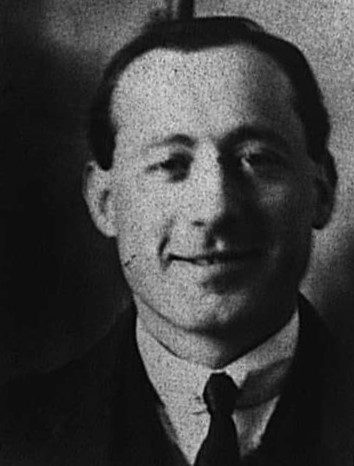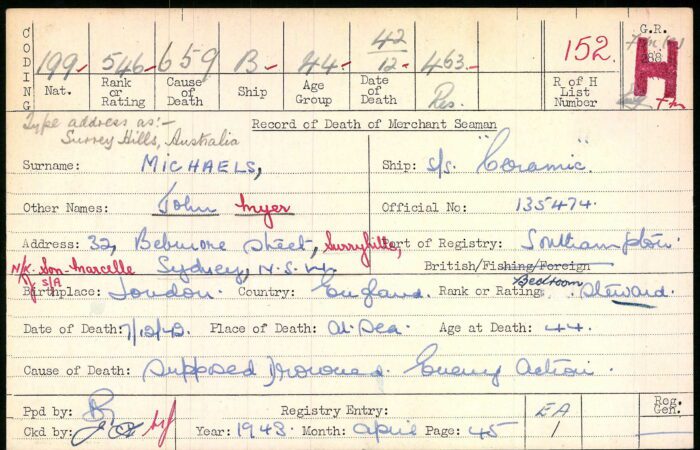John Myer Michaels
Steward, S.S. Ceramic
Died 7 Dec 1942
Commemorated at Tower Hill Memorial
Age 44
John was born on 3 March 1893 in Whitechapel, London. Little else is known about his life but records state that he had a son Marcel living in Sunny Hills, Sydney, Australia.
John worked as a bedroom steward on the S.S. Ceramic a steam ocean liner.
On 3 November 1942 the Ceramic left Liverpool for Australia via St Helena and South Africa carrying 377 passengers, 264 crew, 14 DEMS gunners and 12,362 tons of cargo. 244 of the passengers were military or naval, including at least 145 Army, 30 Royal Navy, 14 Royal Australian Navy and 12 Royal Marines. 30 of the Army passengers were QAIMNS nursing sisters. The other 133 passengers were fare-paying civilians. 12 were children, the youngest being a one-year-old baby girl. Six were doctors, five of whom were South African.
Ceramic sailed with Convoy ON 149 until it dispersed as scheduled in the North Atlantic. She then continued unescorted as planned. At midnight on 6–7 December, in cold weather and rough seas in mid-Atlantic, U-515 hit the ship with a single torpedo. These were followed two or three minutes later by two more that hit Ceramic’s engine room, stopping her engines and her electric lighting. The liner radioed a distress signal, which was received by the HMS Enterprise. The crippled liner stayed afloat, and her complement abandoned ship, launching about eight lifeboats all full of survivors. About three hours later U-515 fired two more torpedoes, which broke the ship’s back and sank her immediately. By now it was very stormy and raining. The heavy sea capsized some of the lifeboats and left many people struggling in the water. Those boats that were not capsized stayed afloat only by constant baling.
The next morning the U-515 to returned to the position of the sinking to find out the ship’s destination. About noon the U-boat commander, decided to rescue the Ceramic’s skipper. In heavy seas, he sighted one of the lifeboats and its occupants waved to him. The storm was now almost Force 10 and almost swamping U-515’s conning tower, so the skipper ordered his crew to make do with the first survivor they could find. This turned out to be Sapper Eric Munday of the Royal Engineers, whom they rescued from the water and took prisoner aboard the submarine.
No other occupants of the lifeboats survived. The storm was too severe for neutral rescue ships to put to sea. On 9 December the Portuguese destroyer NRP Dao was sent to search for survivors but found none.
Munday was kept prisoner aboard U-515 for a month, including Christmas and New Year, until she completed her patrol. When she returned to Lorient, Brittany on 6 January 1943 he was landed and sent to Stalag V111-B where he remained a prisoner of war until 1945.
Wikipedia


